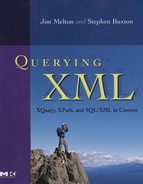Table of Contents
The Morgan Kaufmann Series in Data Management Systems
Part I: XML: Documents and Data
1.3 XML-Based Markup Languages
1.5 Some Other Ways to Represent Data
2.3 Querying Nontraditional Data
3.2 Navigating an XML Document
3.3 What Do You Know about Your Data?
3.4 Some Ways to Query XML Today
Chapter 4: Metadata – An Overview
Chapter 5: Structural Metadata
5.4 Other Schema Languages for XML
5.5 Deriving an Implied Schema from a DTD
Chapter 6: The XML Information Set (Infoset) and Beyond
6.3 The Infoset Information Items and Their Properties
6.4 The Infoset vs. the Document
6.6 The Post-Schema-Validation Infoset (PSVI)
6.7 The Document Object Model (DOM) – An API
6.8 Introducing the XQuery Data Model
6.9 A Note Regarding Data Model Terminology
6.10 Chapter Summary and Further Reading
Part III: Managing and Storing XML for Querying
Chapter 7: Managing XML: Transforming and Connecting
7.2 Transforming, Formatting, and Displaying XML
7.3 The Relationships between XML Documents
7.4 Relationship Constraints: Enforcing Consistency
Chapter 8: Storing: XML and Databases
8.4 Accessing Persistent XML Data
8.5 XML on the Fly: Nonpersistent XML Data
Chapter 9: XPath 1.0 and XPath 2.0
Chapter 10: Introduction to XQuery 1.0
10.5 The XQuery 1.0 Suite of Specifications
10.8 XQuery 1.0 Formal Semantics and Static Typing
10.10 XQuery 1.0 and XSLT 2.0 Serialization
Chapter 11: XQuery 1.0 Definition
11.3 The XQuery Processing Model
11.8 Modules and Query Prologs
11.9 A Longer Example with Data
11.10 XQuery for SQL Programmers
12.3 The XQueryX Specification
15.2 SQL/XML Publishing Functions
15.5 Managing XML in the Database
15.6 Talking the Same Language – Mappings
Part V: Querying and The World Wide Web
Chapter 16: XML-Derived Markup Languages
16.3 Discovery on the World Wide Web
16.4 Customized Query Languages
Chapter 17: Internationalization: Putting the “W” in “WWW”
17.2 What Is Internationalization?
17.3 Internationalization and the World Wide Web
17.4 Internationalization Implications: XPath, XQuery, and SQL/XML
18.2 Finding Structured Data – Databases
18.3 Finding Stuff on the Web – Web Search
18.4 Finding Stuff at Work – Enterprise Search
18.5 Finding Other People’s Stuff – Federated Search
18.6 Finding Services – WSDL, UDDI, WSIL, RDDL
18.7 Finding Stuff in a More Natural Way
18.8 Putting It All Together – The Semantic Web+
